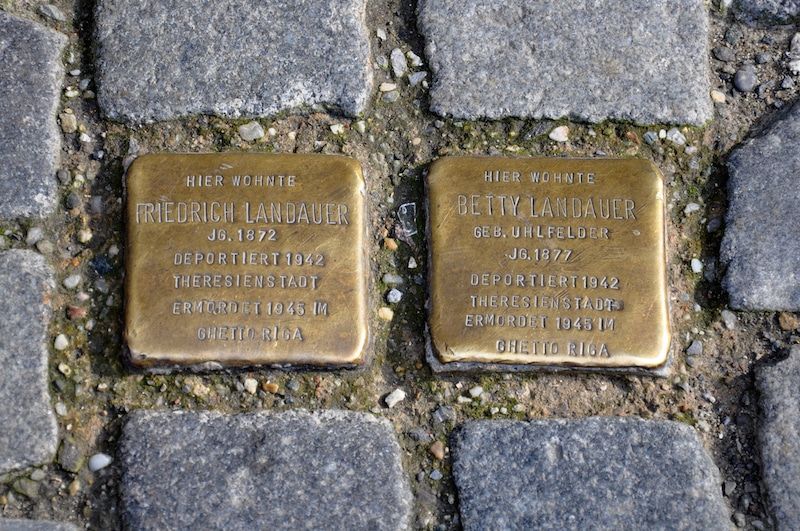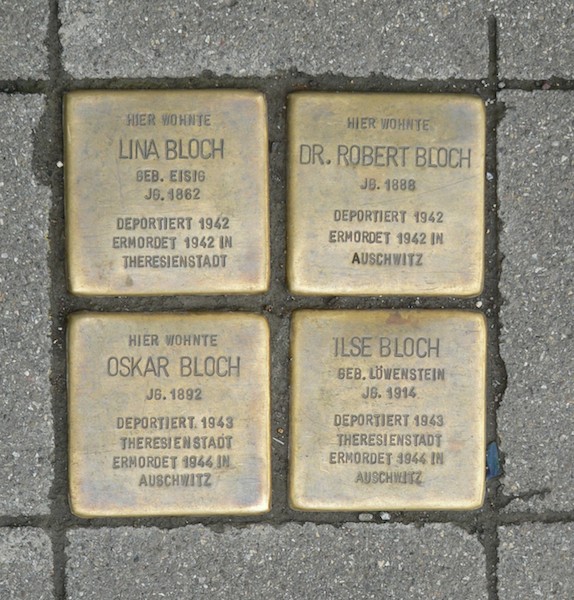The Stolpersteine, or Stumbling Blocks, are one artists legacy to return significance to individual lives destroyed by the holocaust, whether a survivor or not. I’ve wanted to share this for a while now as we’ve seen them in Prague, Berlin and Vienna. The next time you find yourself in Europe, depending on the city, admiring the old buildings, take a quick scan of the sidewalk near the entrances and see if you see a small brass plaque. It may be the former home of a person that was deported to a concentration camp.
In the late 1930’s and early 1940’s the Nazi’s began systematically deporting people to concentration camps and extermination camps. I say people in general because it was not only Jews that were targeted, it was Romani, Sinti, Homosexuals, Poles, communists, Jehovah’s Witnesses, or anyone else the Nazi regime felt unworthy of life. This is difficult enough to grasp and the sheer numbers involved are even more so. As the empire grew so did the number of families torn from their home. Homes most would never see again.
After the camps were liberated in 1944 and 1945, any survivors were nursed and eventually released, but released to what and where exactly? Good question. Many were transferred from such a long distance that it took quite some effort to get back to their home, or they just didn’t. Many of those that did return to their home either found someone else living in it, with no way to prove otherwise, or it had been destroyed.
Since 1996, a Berlin artist by the name of Gunter Demnig has sought to help restore some identity to the victims, to humanize them again. At one time, they were regular people, living regular lives before it was torn apart. His art installation called Stolpersteine, which means stumbling stones, are small brass plaques stamped with the name, birthdate, deportation date, where they were deported to, and their fate, if known, and placed near the doorway of the last known address of the victim. Each stone begins with the words “Hier Wohnte”, here lived.

On the website he refers to the inspiration behind the project to the saying from the Talmud that “a person is only forgotten when his or her name is forgotten.” So each stumbling stone is a small memorial to one person. In the case of an entire family, each will have their own stumbling stone grouped together.

There are over 40,000 of these in over 600 cities throughout Europe and more are laid each year in a small ceremony. Since I spotted my first one, I seem to spot them everywhere we visit across the continent and my heart sinks a little further each time, but I stop and read each one of them and I encourage you to do the same.
Specifically, in Prague, you can find one on Wenceslas Square up the steps from Mustek metro stop at the entrance to an apartment building beside Marks & Spencer, but there are many in Prague and across the Czech Republic. Click here for the interactive map.
Did you know about this? Have you seen any of these, if so, where?

I’m not sure whether or not I saw these in my travels… I might have but just didn’t know what they were! Great post Geoff, and thanks for the info! I’ll be sure to look for them the next time I’m in Germany.
I hate that: when you see something on your journey but don’t really know what it is, only to find out when you’re home again. Doh! But really, these things are easy to miss. There are two right near our flat in Prague, and people spend all day walking over them and never noticing. Such an interesting story though!
Pingback: Everyday War Memorials in Hannover, Germany: Reflections & Remember
Pingback: The 6 Best Day Trips from Prague: Prague Travel Recommendations